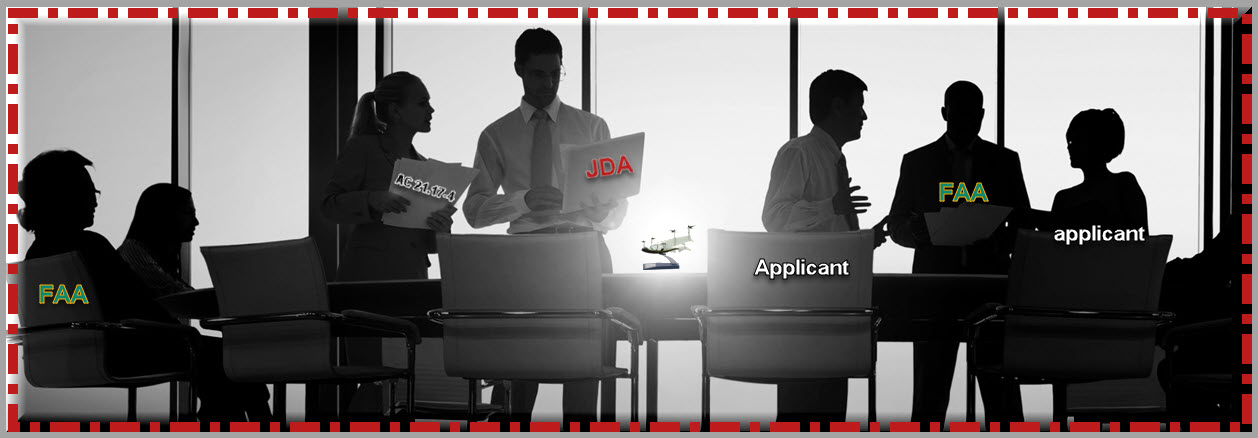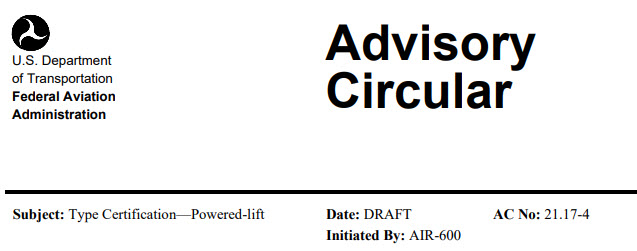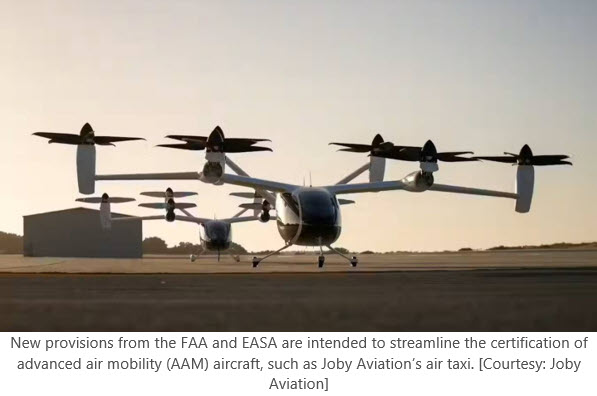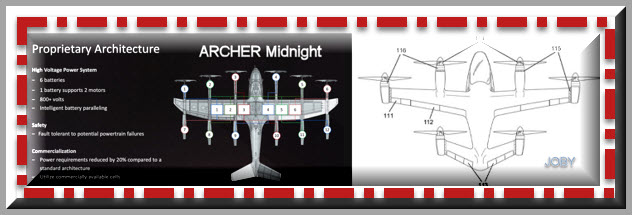EASA & FAA harmonize eVTOL certification criteria, BUT one size does not fit all

The FAA and EASA issued a “significant milestone” statement (see below) on their closely-aligning their certification standards for electric Vertical and Take-Off (eVTOL) aircraft. HARMONIZATION, in many ways, is a most desirable development for the crowded field of entrepreneurs entering this innovative market.
At the same time, those competitors MAY NOT FIT EASILY INTO THE TWO CERTIFCATING AUTHORITIES’ CRITERIA. The FAA’s Advisory Circular (AC 21.17-4 Type Certification—Powered-lift; see below) is written in PERFORMANCE-BASED rather than the old prescriptive (check list) terms, but even still the innovative dimensions of the possible designs for propellors, energy sources (lithium, hydrogen, SAF???), tilt-rotors (wide variation in tilt mechanics and placement), materials, cabin design, navigation, control systems, wings to name a few in prospective TC applications MAY NOT FIT the parameters of AC 21.17-4.
The standard language of an AC adds to the flexibility that will applies to these designs:
- This AC also designates the criteria in appendix A as an acceptable means, BUT NOT THE ONLY MEANS, of showing compliance with title 14 of the Code of Federal Regulations (14 CFR) 21.17(b) for Federal Aviation Administration (FAA) type certification of certain powered-lift.
The AC benefits from the experiences of EASA and FAA in working through their pending TC applications for eVTOLs. The draft circular is based on those lessons. The policy recognizes that future eVTOLs will need different airworthiness tests (see paragraph 4.3 of the draft AC).
The advice also notes that the Administrator may (likely?) add new requirements are needed because the performance standards of “appendix A” may be “INADEQUATE OR OTHERWISE inappropriate.” Another possible alteration to the process is reserved, IF NOISE rears its ugly head as a problem, paragraph 6.3 states:
The FAA WILL EXAMINE EACH POWERED-LIFT APPLICATION AND DETERMINE WHETHER THE EXISTING PART 36 REQUIREMENTS ARE APPROPRIATE AS A NOISE CERTIFICATION BASIS, AS IT DOES FOR ALL NOISE CERTIFICATION APPLICANTS.
The FAA’s Aircraft Certification organization is still in the midst of transition of lead authorities. The precise locus of some technical disciplines is not clear. In recognition that some of field offices may not be well equipped for an eVTOL TC application, Paragraph 6.1.3 provides an option to assure consistency when it adds:
AIR-600 MAY PARTICIPATE AT ITS DISCRETION in powered-lift type certification projects.
The potential, that Washington may intervene in a TC process, will motivate the field to coordinate closely with national policy developments.
Appendix A (all 53 pages; see article and excerpts below) is a lengthy definition of the standards an applicant must meet to demonstrate the aircraft’s airworthiness. The Flying magazine examines the salient modifications made by the 2 certification authorities; well worth noting.
Though the goal is to standardize the eVTOL processes and standards, it is likely that a TC applicant will encounter unexpected problems—some due to a novel design issue, others because the local office is uncomfortable with technical problems—necessitating the tricky request for intervention, or an evolution in FAA’s standards. An SME, particularly someone who has dealt with similar hiccups or personnel personality problems, will be a critical facilitator of resolving such a roadblock.

+++++++++++++++++++
FAA Statement on eVTOL Aircraft Certification
Monday, June 10, 2024
The Federal Aviation Administration (FAA) and European Union Aviation Safety Agency (EASA) have achieved A SIGNIFICANT MILESTONE ON THE PATH TO CERTIFYING ELECTRIC VERTICAL TAKE-OFF AND LANDING (EVTOL) AIRCRAFT. This also marks important progress in our effort to more closely align rulemaking and policy initiatives between the United States and the European Union. We’re committed to ensuring the safety of the flying public both at home and abroad.
Review the Advisory Circular: AC 21.17-4 Type Certification—Powered-lift

- This AC also designates the criteria in appendix A as an acceptable means, BUT NOT THE ONLY MEANS, of showing compliance with title 14 of the Code of Federal Regulations (14 CFR) 21.17(b) for Federal Aviation Administration (FAA) type certification of certain powered-lift.
2.1 cites fifteen Parts of 14 CFR as applicable
2.2 Cites 11 Publications (Orders and Acs) as applicable
4.2 In the event that the airworthiness criteria prescribed in appendix A of this AC are inadequate or otherwise inappropriate as a certification basis of a specific powered-lift due to its unique design or design features, other criteria may be developed using the process in paragraph 7.2 of this AC.
4.3 FOR NEW PROJECTS, APPLICANTS MAY PROPOSE USING AIRWORTHINESS CRITERIA FROM THE CERTIFICATION BASIS OF PREVIOUSLY APPROVED POWERED-LIFT DESIGNS…
4.5 The PERFORMANCE-BASED airworthiness criteria in appendix A capture the safety intent of each requirement…
5.2 The airworthiness criteria in appendix A of this AC apply to powered-lift with a MAXIMUM GROSS WEIGHT OF 12,500 POUNDS OR LESS, a passenger seating configuration of six or less, and a battery-powered electric engine(s) for propulsion.
6.1.3 AIR-600 is responsible for national technical policy standardization concerning the development and use of powered-lift airworthiness criteria, including the type certification of powered-lift as special class of aircraft under § 21.17 (b). AIR-600 MAY PARTICIPATE AT ITS DISCRETION in powered-lift type certification projects. This will ensure that the airworthiness criteria developed for powered-lift are properly and consistently interpreted and applied
7.2 Other Airworthiness Criteria. In the event the Administrator finds that COMPLIANCE with airworthiness criteria in appendix A is INADEQUATE OR OTHERWISE inappropriate as a certification basis of a powered-lift due to its unique design or design features, the Administrator may require an applicant to comply with alternate or additional criteria…
7.5 Noise Regulations. The FAA is mandated to establish noise standards and regulations that ensure public safety regarding aircraft noise. The FAA WILL EXAMINE EACH POWERED-LIFT APPLICATION AND DETERMINE WHETHER THE EXISTING PART 36 REQUIREMENTS ARE APPROPRIATE AS A NOISE CERTIFICATION BASIS, AS IT DOES FOR ALL NOISE CERTIFICATION APPLICANTS. Part 36 does contain noise standards for tiltrotors, a class of aircraft within the powered-lift category. If the FAA determines that the part 36 noise standards are not sufficient for a particular powered-lift design, the FAA will prescribe a rule of particular applicability and publish the specific noise requirements for that powered-lift in the Federal Register.
Appendix A. Airworthiness Criteria for Powered-Lift
53 pages
(sampling of first 20 pages to show the level of granularity of these technical criteria)
AIRCRAFT LEVEL REQUIREMENTS
PL.1457 Cockpit voice recorders.
PL.1459 Flight data recorders.
PL.1529 Instructions for continued airworthiness.
PL.2010 Accepted means of compliance.
PL.2105 Performance data.
PL.2110 Minimum safe speed.
PL.2115 Takeoff performance.
PL.2120 Climb requirements.
PL.2125 Climb information.
PL.2130 Landing.
FLIGHT CHARACTERISTICS
PL.2135 Controllability.
PL.2140 Trim.
PL.2145 Stability.
PL.2150 Minimum safe speed characteristics and warning
PL.2155 Ground and water handling characteristics.
PL.2160 Vibration, buffeting, and high-speed characteristics
PL.2165 Performance and flight characteristics requirements for flight in atmospheric icing conditions.
SUBPART C—STRUCTURES
PL.2200 Structural design envelope.
PL.2205 Interaction of systems and structures.
STRUCTURAL LOADS
PL.2210 Structural design loads.
PL.2220 Ground and water load conditions
PL.2225 Component loading conditions.
PL.2230 Limit and ultimate loads.
STRUCTURAL PERFORMANCE
PL.2235 Structural strength.
PL.2240 Structural durability.
PL.2241 Aeromechanical stability
PL.2245 Aeroelasticity.
Design PL.2250
DESIGN AND CONSTRUCTION PRINCIPLES
PL.2410 Powerplant installation hazard assessment.
PL.2415 Powerplant ice protection
PL.2425 Powerplant operational characteristics
PL.2430 Energy systems.
++++++++++++++++++++
FAA, EASA Release New Certification Criteria for Air Taxis
The proposed standards represent a major milestone in the certification of electric vertical takeoff and landing (eVOL) air taxis and other novel designs.
Updated Jun 11, 2024 9:25 AM EDT

The FAA and European Union Aviation Safety Agency (EASA) on Monday made major strides toward establishing a certification pathway for advanced air mobility (AAM) aircraft, such as electric vertical takeoff and landing (eVTOL) air taxis.

The FAA—which so far has published final airworthiness criteria for two air taxi designs, Archer Aviation’s Midnight and Joby Aviation’s flagship model—issued an advisory circular (AC) that would create the foundation for certification of powered lift vehicles, such as eVTOL aircraft. The AC, which lays out acceptable means for showing compliance with FAA Part 21 requirements for special class aircraft, is OPEN FOR COMMENT FOR 60 DAYS.
EASA, meanwhile, updated its special condition for vertical takeoff and landing aircraft (SC-VTOL) rules to incorporate new requirements agreed upon with the FAA, covering safe flight and landing, handling qualities, and single-point failures.
Simultaneously, the regulators together revised Safety Emphasis Items (SEI) lists—which determine an agency’s level of involvement in aircraft validation projects—for parts 23, 27, and 29. According to the FAA, the partners have reduced SEI requirements and placed greater responsibility on the authority actually certifying the aircraft.
“The FAA and EASA have achieved a SIGNIFICANT MILESTONE on the path to certifying eVTOL aircraft,” the FAA said in a statement. “This also marks important progress in our effort to more closely align rulemaking and policy initiatives between the United States and the European Union. We’re committed to ensuring the safety of the flying public both at home and abroad.”
Both the FAA and EASA have announced ambitious initiatives designed to cement their respective AAM industries as the world’s biggest and best. But before tackling challenges such as eVTOL infrastructure, which will require a network of vertiports and electric chargers to support the aircraft, the regulators first need to define clear certification pathways for the novel designs.
The FAA’s new criteria, intended for powered lift designs with maximum weights of 12,500 pounds and a maximum capacity of six passengers, were developed using standards in FAA parts 23, 27, 33, and 35. The regulator said it leveraged its work on Archer and Joby’s type certification applications to develop the standards, claiming they will create a more efficient path to developing the certification bases for powered lift projects.
For example, the FAA will NO LONGER NEED TO PUBLISH AIRWORTHINESS CRITERIA IN THE FEDERAL REGISTER for public notice and comment, as it was required to do for Archer and Joby’s aircraft, for designs that use the standards in the AC. Applicants can now propose certification bases that draw from previously approved designs, such as Archer’s Midnight, or use equivalent level of safety findings to adopt existing airworthiness criteria for their own projects.
EASA, which had already published an initial set of standards for VTOL projects, made a few key changes in the second issue of its SC-VTOL criteria. Unlike the FAA AC, it will not be subject to public consultation.
The MOST NOTABLE CHANGE is an increase of the maximum certified takeoff mass (MCTOM) from 7,000 pounds to about 12,500 pounds, one of many examples of the regulator adjusting standards or wording to better align with the FAA AC.
ANOTHER KEY PROVISION is the introduction of a requirement around electrical wiring interconnection systems (EWIS), which transmit data and signals across aircraft systems. Manufacturers will need to prove these can be operated without risk.
So far, China’s EHang is the only eVTOL manufacturer in the world to achieve type certification, awarded by China’s Civil Aviation Authority (CAAC) for the company’s EH216-S in October. Already, the manufacturer has completed commercial demonstration flights and begun mass production.
Things are moving a bit slower in the West, much to the chagrin of U.S. lawmakers and regulators, who don’t anticipate AAM operations at scale until 2028. It’s no secret that Western officials are wary of Chinese drones and electric vehicles, and the country’s growing AAM industry could be a threat to their dominance in that sphere as well.
Monday’s announcements should help accelerate the technology’s growth in the U.S. and Europe. In the coming months, expect the list of eVTOL companies with type certification bases to grow beyond Archer, Joby, and the handful of companies, among them Lilium and Volocopter, collaborating with EASA.

+++++++++++++++++++